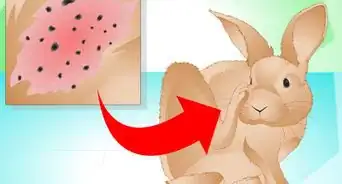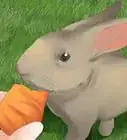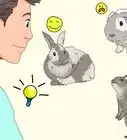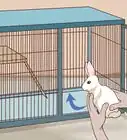This article was co-authored by Pippa Elliott, MRCVS. Dr. Elliott, BVMS, MRCVS is a veterinarian with over 30 years of experience in veterinary surgery and companion animal practice. She graduated from the University of Glasgow in 1987 with a degree in veterinary medicine and surgery. She has worked at the same animal clinic in her hometown for over 20 years.
wikiHow marks an article as reader-approved once it receives enough positive feedback. In this case, several readers have written to tell us that this article was helpful to them, earning it our reader-approved status.
This article has been viewed 320,681 times.
Rabbits are naturally inclined to hide illness.[1] The most important factor in keeping your rabbit healthy is to know and be attentive to clues that your rabbit is sick. If you observe such clues, you should take your rabbit to the vet, but veterinarians qualified to treat rabbits are not always available. There are some ways, however, to help your rabbit in the meantime.
Steps
Recognizing Illness
-
1Watch for changes in behavior. Not all rabbits are friendly. But if your rabbit usually leaps around and greets, but suddenly ceases to do so, this is an indication that something might be wrong. Watch for signs that your rabbit is less mobile than usual, such as hunching over or limping. [2]
-
2Observe eating habits. If your rabbit is not eating normally, it might be ill. Watch for leftover food from the last feeding. Also, monitor its droppings. If there are no droppings in the litterbox this indicates that the rabbit is not eating. Be attentive to the size and shape of the droppings. Ideally, the droppings should be large and round. If they are small, irregular, or liquid, it is possible that your rabbit is sick. [3]Advertisement
-
3Listen for tooth grinding. Your rabbit will often make a soft, grinding sound with its teeth when it is happy. However, if the sound is louder than normal it could be a bad sign. Often this is an indication that your rabbit is in pain.[4]
-
4Test for signs of illness. Begin by offering your rabbit its favorite treat. If it refuses to eat the treat, it might be sick. Move on to testing the rabbit’s temperature. If it is well, the temperature should be between 101⁰F-103⁰F.
- You should ask your veterinarian to demonstrate how to take your rabbit’s temperature. If you do this in advance of any signs of illness, you will be prepared in case of an emergency.
- To take your bunny’s temperature you will want to place it on its back, either on a padded surface or your lap. Hold your rabbit’s head and shoulder against your stomach, so that its back curls into a “C” shape. Secure the rabbit’s back legs so that it does not kick. Once it is calm insert a lubricated plastic thermometer no more than one inch into its rectum. Be sure that the rabbit is well restrained and is not able to move while you take its temperature.[5]
- Do your best to cool your rabbit off if it has a high fever by putting cold objects up against its ears until the temperature drops to less than 104 degrees.[6]
Treating Tooth Disease
-
1Recognize tooth disease. Dental disease can be caused by a misalignment of the teeth or the wearing down of a tooth. This can be a dangerous situation. It can cause your bunny to stop eating, endangering its health.
- Signs of tooth disease include loss of appetite, hair loss on chin and neck, slobbering, and drooling. Your rabbit might still show signs that it has an appetite, but is unable to eat. Perhaps it will approach food, even pick it up, before backing off and dropping it.
- If you believe that your rabbit might have tooth disease rub its cheeks. Any evidence of discomfort would suggest that it has a dental problem.[7]
-
2Feed your rabbit soft food. Until you can reach a veterinarian, try to force-feed your rabbit canned pumpkin, baby-food, or veggies. You can purchase a feeding syringe from a pet store. These can be used to insert fluid directly into the rabbit’s mouth.
- To prepare for syringe feeding, wrap your rabbit in a towel and secure its head with an index finger under the head, and the thumb on the opposite end of the head, under the base of the skull.
- Insert the syringe into the gap between the incisors and cheek teeth. Begin by inserting no more than .2 to .5 milliliters (0.02 fl oz) of food and never feed more than 1 milliliter (0.034 fl oz). Too much food at one time creates the risk that the rabbit will choke. Go slowly. Then repeat with 5 to 10 milliliters (0.17 to 0.34 fl oz) of water.
-
3Take your rabbit to a veterinarian. Ultimately your rabbit will need professional assistance. Because of the variety of possible dental issues, treatment varies. If you do not do so already, you should begin yearly dental examinations to ensure that there are no future complications.
Treating Gas Pain
-
1Watch for signs of gas pain. As with many other disorders, gas pain will cause lack of appetite. What will distinguish gas pain, however, is a loud gurgling sound in the gut. Your rabbit might also stretch out, as if it is pressing its belly against the floor.[8]
- Gastrointestinal problems are usually accompanied by a drastic, sometimes complete decrease in fecal production. Keep your rabbit comfortable and hydrated until you get to the vet.
- Gas pain will typically cause below average body temperature. If your rabbit’s temperature is below 101⁰F, it might suffer from gas pain.
-
2Warm your rabbit. You should try to counteract the rabbit’s drop in temperature. Try putting the rabbit on a warm (not hot) heating pad or a hot-water bottle wrapped in a towel. You can also warm the rabbit with your body heat, holding it close to you for an hour or longer.[9]
-
3Massage your rabbit. A gentle belly message can help relieve the pressure of the gas. Massage frequently for periods of ten or fifteen minutes. For at least part of this period you should have hindquarters elevated.[10]
Treating Head Tilt
-
1Recognize head tilt. Head tilt is a frightening disorder, also known as wry neck, typically caused by an inner ear infection. Your rabbit will lose its sense of balance. It will look dizzy and uncoordinated. Its head will twist and its eyes might dart quickly from one direction to the other.[11]
-
2Protect your bunny. There is nothing you can do to reduce the effects of head tilt at home. But you should do your best to prevent your rabbit from hurting itself. Make a box well-padded with towels or another soft object. You want to make sure that if your rabbit falls over or jumps into a wall, it does as little damage as possible.[12]
- If your bunny seems to be physically unable to eat, feed with a syringe as described above.
-
3Take your bunny to a veterinarian who regularly treats rabbits. Head tilt can be a persistent condition, often lasting for several months. Some veterinarians without experience with it will recommend that you euthanize your bunny. However, if you are persist, the condition can often be treated.[13]
Treating Injuries
-
1Treat a broken or bleeding nail. Wrap the paw in a clean towel and apply pressure. Stop applying pressure when the bleeding stops. Afterwards, keep the broken nail clean. Clean the litter box and cage bottom repeatedly so that bacteria doesn't enter the wound.
- You can also rub styptic powder, plain flour, or a bar of soap on the end of the nail to help stop the bleeding.[14]
-
2Treat a broken bone. There is little you can do to fix a broken bone. Take your rabbit to the vet immediately if it has broken a bone. If your vet is not available, take the rabbit to an emergency clinic. Until the injury is attended to by a professional vet, try to keep your rabbit from moving around.
- Place food and water close to the rabbit in an enclosed space. This way it will not need to move to take care of itself.[15]
-
3Take your rabbit to the veterinarian if it sustains an eye injury. It is tempting to give your bunny an eye drop, but this can cause considerable damage.[16] All that you can do before going to a veterinarian is wet a cotton ball with warm water and gently wipe your rabbit's eyes to remove build-up.
-
4Treat bite wounds. Rabbits often bite each other. While the wounds themselves might not appear bad, they often carry bacteria that can make for a dangerous situation. You should see a veterinarian after any bite wound. In the interim period, try to stop the bleeding and prevent infection.
- Apply pressure with a towel or gauze to stop bleeding.
- Once bleeding has stopped, wash the area with Nolvasan. Then apply Neosporin, triple antibiotic ointment. Do not use Neosporin Plus.
Expert Q&A
Did you know you can get expert answers for this article?
Unlock expert answers by supporting wikiHow
-
QuestionMy rabbits turn 12 months on July 27th. They both have diarrhea. I have cleaned their cages, bathed them in warm water to clean their poopy butts, and given them fresh food and water. One is eating the hay but the other doesn't. What else should I do for them?
 Pippa Elliott, MRCVSDr. Elliott, BVMS, MRCVS is a veterinarian with over 30 years of experience in veterinary surgery and companion animal practice. She graduated from the University of Glasgow in 1987 with a degree in veterinary medicine and surgery. She has worked at the same animal clinic in her hometown for over 20 years.
Pippa Elliott, MRCVSDr. Elliott, BVMS, MRCVS is a veterinarian with over 30 years of experience in veterinary surgery and companion animal practice. She graduated from the University of Glasgow in 1987 with a degree in veterinary medicine and surgery. She has worked at the same animal clinic in her hometown for over 20 years.
Veterinarian Fiber is the best thing for diarrhea in rabbits, so try and encourage both to eat hay. For the rabbit that doesn't eat hay, get the freshest, greenest hay you can find and chop it up with scissors to make it easier to eat. In addition, source some rabbit probiotics, which can help recolonize the gut with the bacteria that help digestion. Be sure to keep their bottoms clean so they don't attract flies.
Fiber is the best thing for diarrhea in rabbits, so try and encourage both to eat hay. For the rabbit that doesn't eat hay, get the freshest, greenest hay you can find and chop it up with scissors to make it easier to eat. In addition, source some rabbit probiotics, which can help recolonize the gut with the bacteria that help digestion. Be sure to keep their bottoms clean so they don't attract flies. -
QuestionMy rabbit is about 8 years old. For about the last two weeks he has stopped eating, even his favorite treats, and barely drinks any water. His droppings are extremely small and his urine is almost gel-like. I've held off taking him to the vet because of his age, but I don't want him to suffer if he's dying.
 Pippa Elliott, MRCVSDr. Elliott, BVMS, MRCVS is a veterinarian with over 30 years of experience in veterinary surgery and companion animal practice. She graduated from the University of Glasgow in 1987 with a degree in veterinary medicine and surgery. She has worked at the same animal clinic in her hometown for over 20 years.
Pippa Elliott, MRCVSDr. Elliott, BVMS, MRCVS is a veterinarian with over 30 years of experience in veterinary surgery and companion animal practice. She graduated from the University of Glasgow in 1987 with a degree in veterinary medicine and surgery. She has worked at the same animal clinic in her hometown for over 20 years.
Veterinarian Try syringing some water slowly into his mouth; however, be aware that not eating means his teeth will grow long, which in turn can stop him from eating. It is best to get him checked as the vet may be able to sort the teeth and suggest medication to get him eating again. If not, don't let him slowly starve, and think about letting him go so he doesn't suffer.
Try syringing some water slowly into his mouth; however, be aware that not eating means his teeth will grow long, which in turn can stop him from eating. It is best to get him checked as the vet may be able to sort the teeth and suggest medication to get him eating again. If not, don't let him slowly starve, and think about letting him go so he doesn't suffer.
References
- ↑ http://www.bio.miami.edu/hare/sickbun.html
- ↑ http://www.rabbit.org/care/sick.html
- ↑ http://www.rabbit.org/care/sick.html
- ↑ http://www.rabbit.org/care/sick.html
- ↑ http://www.bio.miami.edu/hare/sickbun.html
- ↑ https://www.petfinder.com/pet-care/rabbit-care/rabbit-sick-reach-vet/
- ↑ https://www.petfinder.com/pet-care/rabbit-care/rabbit-sick-reach-vet/
- ↑ https://www.petfinder.com/pet-care/rabbit-care/rabbit-sick-reach-vet/
- ↑ https://www.petfinder.com/pet-care/rabbit-care/rabbit-sick-reach-vet/
- ↑ https://www.petfinder.com/pet-care/rabbit-care/rabbit-sick-reach-vet/
- ↑ http://www.rabbit.org/care/sick.html
- ↑ https://www.petfinder.com/pet-care/rabbit-care/rabbit-sick-reach-vet/
- ↑ https://www.petfinder.com/pet-care/rabbit-care/rabbit-sick-reach-vet/
- ↑ https://www.petfinder.com/pet-care/rabbit-care/rabbit-sick-reach-vet/
- ↑ https://www.petfinder.com/pet-care/rabbit-care/rabbit-sick-reach-vet/
- ↑ https://www.petfinder.com/pet-care/rabbit-care/rabbit-sick-reach-vet/
About This Article
To deal with a sick rabbit, it's best to take it to a vet for an evaluation. Then, you can move forward with the best treatment plan for your bunny's situation. If your rabbit has lost its appetite or refuses to eat, you can try feeding it canned pumpkin or baby food with a feeding syringe until you can get it to the vet. If you hear loud gurgling sounds coming from your rabbit's tummy, it may have gas pain, which is fairly common in rabbits. You can gently massage its belly to relieve gas pressure. For more tips from our Veterinary co-author on dealing with symptoms, read on!
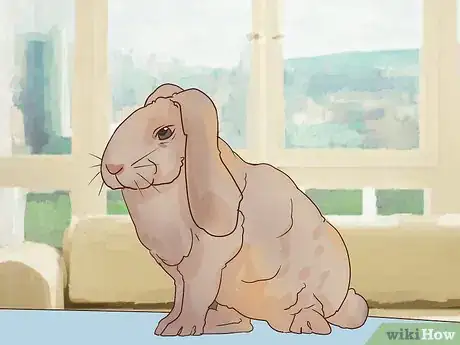
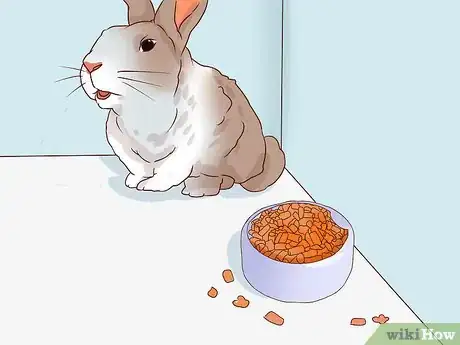

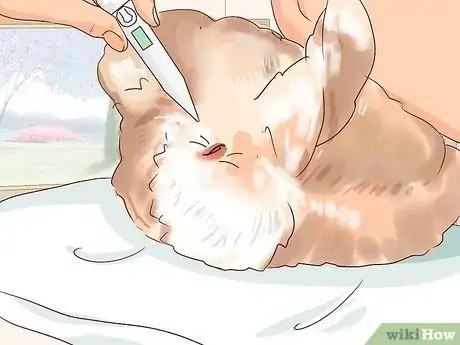
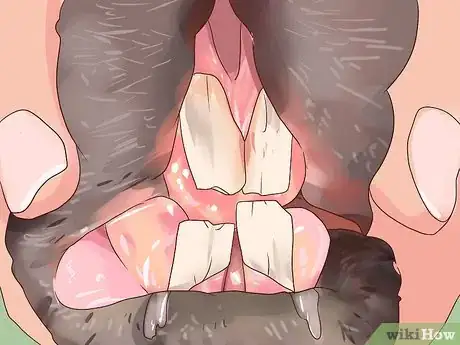

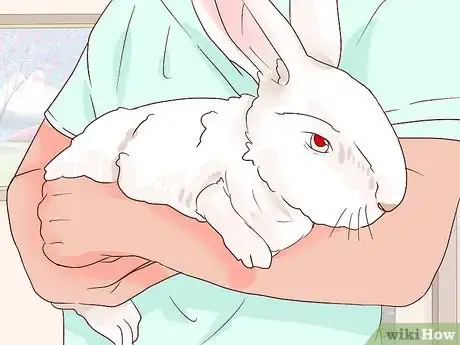
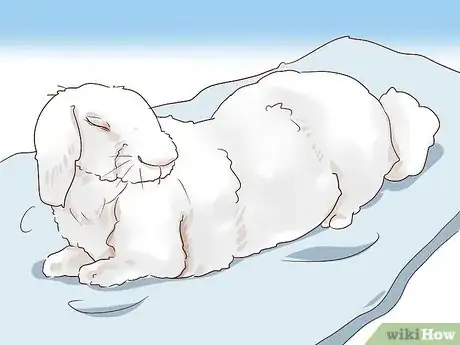
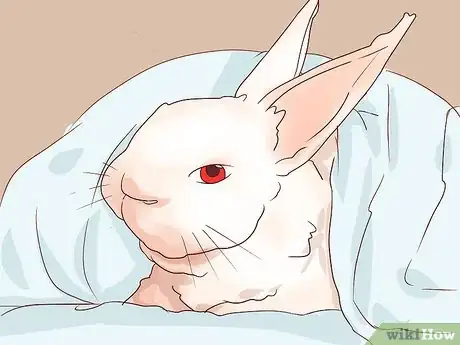


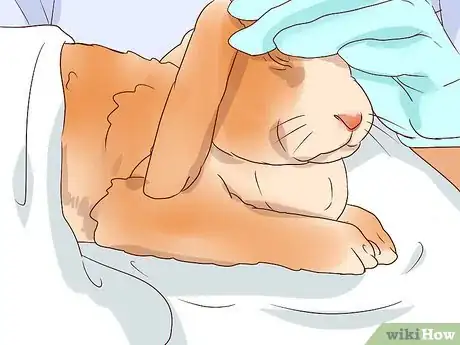
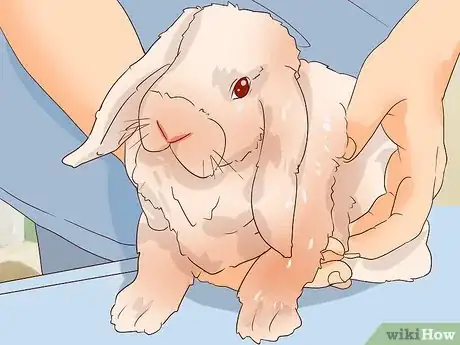

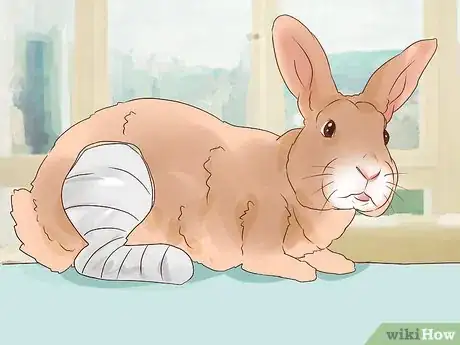
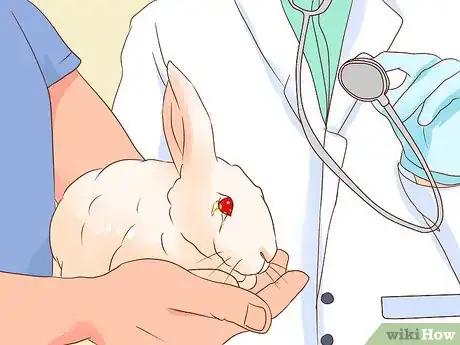
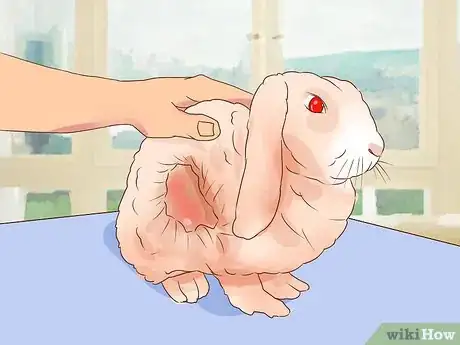



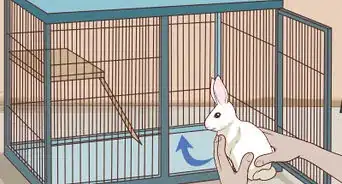


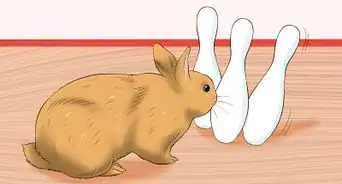
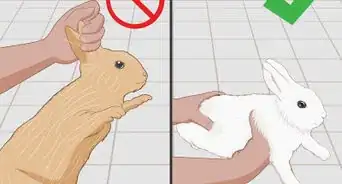
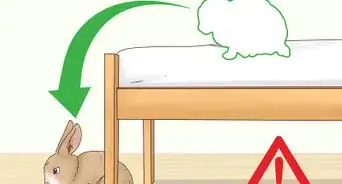

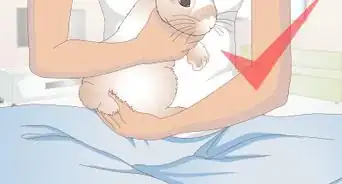
-in-Rabbits-Step-12.webp)
